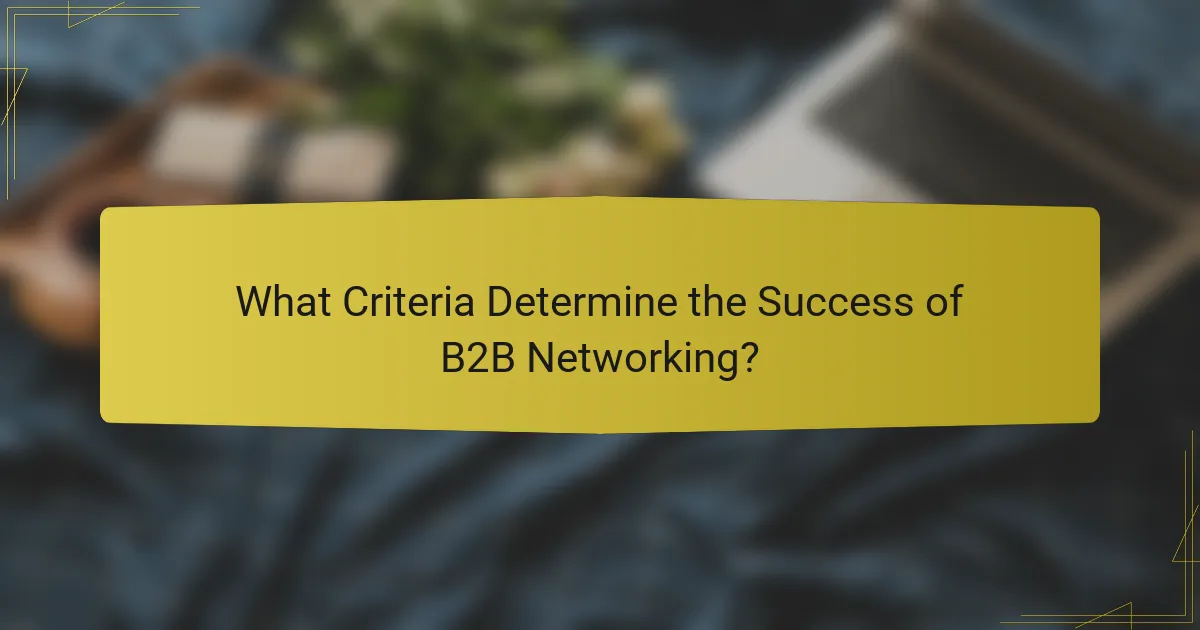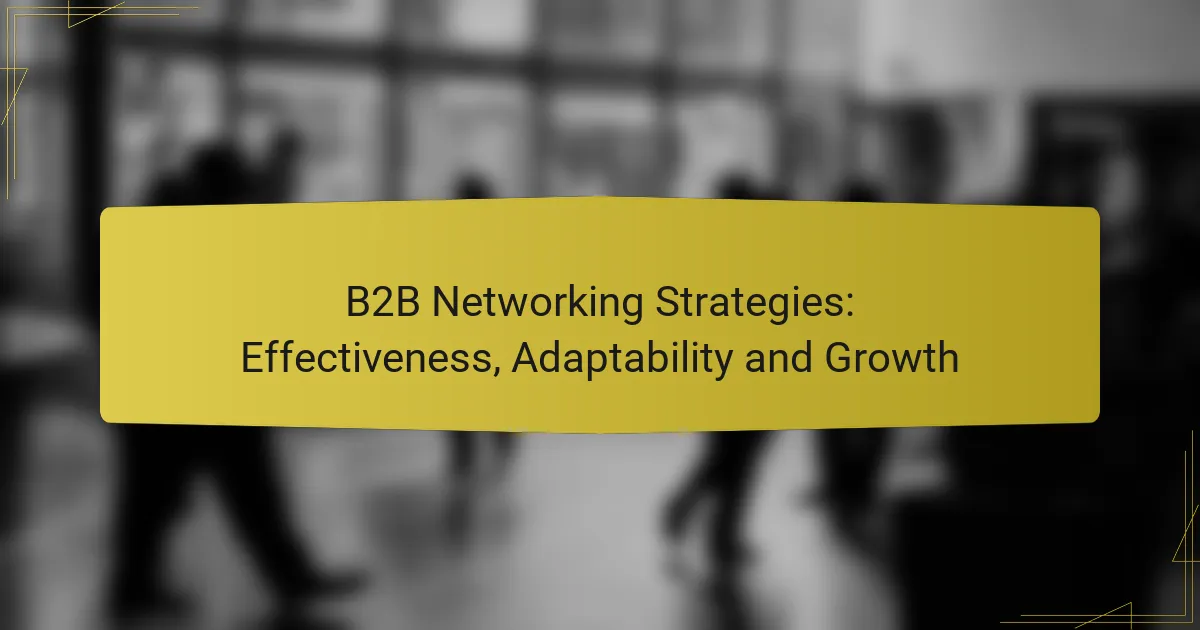B2B networking strategies are essential for fostering relationships that can lead to valuable business opportunities and collaborations. To remain effective, these strategies must adapt to changing market dynamics by embracing new technologies and personalizing outreach efforts. Ultimately, the success of networking initiatives hinges on engagement levels and the ability to cultivate long-term partnerships.

What Are the Most Effective B2B Networking Strategies?
Effective B2B networking strategies focus on building relationships that lead to business opportunities and collaborations. These strategies leverage various platforms and events to connect with potential partners, clients, and industry leaders.
Leveraging LinkedIn for Connections
LinkedIn is a powerful tool for B2B networking, allowing professionals to connect, share insights, and showcase their expertise. To maximize your presence, regularly update your profile, engage with relevant content, and join industry-specific groups.
Consider sending personalized connection requests that highlight mutual interests or shared connections. This approach increases the likelihood of acceptance and lays the groundwork for meaningful conversations.
Participating in Industry Conferences
Industry conferences offer invaluable opportunities for networking with peers and potential clients. Attending these events allows you to meet face-to-face, exchange ideas, and establish rapport.
Prepare by researching attendees and speakers beforehand. Set specific goals for the event, such as connecting with a certain number of individuals or scheduling follow-up meetings. Follow up with new contacts after the conference to reinforce the connection.
Utilizing Networking Platforms like Meetup
Networking platforms such as Meetup facilitate connections through organized events tailored to specific interests or industries. These gatherings can range from casual meetups to structured workshops, providing diverse networking opportunities.
Join groups relevant to your field and actively participate in events. This engagement not only expands your network but also positions you as an active member of your industry community.
Building Strategic Partnerships
Strategic partnerships involve collaborating with other businesses to achieve mutual goals. This approach can enhance your market reach and provide access to new resources or expertise.
Identify potential partners whose strengths complement your own. Establish clear objectives for the partnership and maintain open communication to ensure alignment and success.
Engaging in Online Communities
Online communities, such as forums and social media groups, are excellent venues for B2B networking. These platforms allow you to engage with industry peers, share knowledge, and seek advice.
Be active in discussions, provide valuable insights, and contribute to community-building efforts. This engagement can lead to connections that may evolve into business opportunities over time.

How Do B2B Networking Strategies Adapt to Market Changes?
B2B networking strategies must evolve to remain effective amidst shifting market dynamics. This adaptability involves leveraging new technologies, responding to industry trends, and personalizing outreach efforts to meet the changing needs of businesses.
Incorporating Digital Tools for Remote Networking
Digital tools have become essential for B2B networking, especially as remote work gains traction. Platforms like LinkedIn, Zoom, and virtual event software facilitate connections that were once limited to in-person meetings.
Utilizing these tools allows businesses to reach a wider audience without geographical constraints. For example, hosting webinars can attract participants from various regions, enhancing visibility and engagement.
Adjusting Approaches Based on Industry Trends
Staying attuned to industry trends is crucial for effective B2B networking. Regularly reviewing market reports and competitor activities can reveal shifts in customer preferences and emerging opportunities.
For instance, if sustainability becomes a priority in your sector, adjusting your networking approach to highlight eco-friendly practices can resonate with potential partners. This responsiveness can differentiate your business and foster stronger connections.
Emphasizing Personalization in Outreach
Personalization is key in B2B networking, as tailored communication fosters trust and engagement. Addressing specific pain points or interests of potential partners can significantly improve response rates.
Consider segmenting your outreach based on industry, company size, or previous interactions. A personalized email that references a recent achievement of the recipient’s company can create a more meaningful connection than a generic message.

What Criteria Determine the Success of B2B Networking?
The success of B2B networking is primarily determined by engagement levels, conversion rates from connections, and the ability to build long-term relationships. These criteria help businesses assess the effectiveness of their networking strategies and identify areas for improvement.
Measuring Engagement Levels
Engagement levels reflect how actively participants interact within a networking context. This can include metrics such as attendance at events, participation in discussions, and responses to outreach efforts. High engagement often indicates a strong interest in collaboration and potential business opportunities.
To measure engagement, consider using tools like surveys or analytics platforms that track interactions. Aim for a diverse range of engagement activities to capture a holistic view of participant involvement.
Tracking Conversion Rates from Connections
Conversion rates from connections indicate how effectively networking efforts lead to tangible business outcomes, such as sales or partnerships. This metric can be calculated by comparing the number of connections made to the number of successful deals or collaborations that arise from those connections.
To improve conversion rates, focus on quality over quantity when establishing connections. Prioritize networking with individuals or companies that align closely with your business goals and values. Regularly review and refine your approach based on what yields the best results.
Evaluating Long-Term Relationship Building
Long-term relationship building is crucial for sustained success in B2B networking. This involves nurturing connections over time, fostering trust, and providing value to partners. Strong relationships often lead to repeat business and referrals, which are vital for growth.
To evaluate relationship strength, consider factors such as frequency of communication, mutual support in business endeavors, and overall satisfaction with the partnership. Regular check-ins and feedback sessions can help maintain and enhance these relationships.

How to Build a B2B Networking Strategy?
Building a B2B networking strategy involves identifying your target audience, establishing clear goals, and creating a structured plan for engagement. Effective networking can lead to valuable partnerships, increased visibility, and business growth.
Identifying Target Audience and Goals
To create a successful B2B networking strategy, start by identifying your target audience. Consider factors such as industry, company size, and decision-makers within those organizations. Establish specific goals for your networking efforts, such as increasing brand awareness, generating leads, or forming strategic alliances.
Utilize tools like LinkedIn to research potential contacts and understand their needs. This targeted approach ensures that your networking efforts are focused and relevant, increasing the likelihood of meaningful connections.
Creating a Networking Plan
A well-structured networking plan outlines how you will engage with your target audience. Begin by selecting appropriate networking channels, such as industry conferences, online forums, or local business events. Determine the frequency of your networking activities, aiming for consistency without overwhelming your schedule.
Incorporate a mix of online and offline strategies. For instance, attend trade shows to meet potential partners face-to-face while also participating in webinars to reach a broader audience. This dual approach can enhance your visibility and foster deeper relationships.
Setting Up Follow-Up Procedures
Establishing follow-up procedures is crucial for maintaining connections made during networking events. After meeting someone, send a personalized email or message within a few days to reinforce the relationship. Mention specific topics discussed to jog their memory and show genuine interest.
Consider implementing a CRM system to track your interactions and schedule follow-ups. This will help you stay organized and ensure that no valuable connections are neglected. Regular check-ins, such as sharing relevant articles or updates, can keep the conversation going and strengthen your network over time.

What Are the Costs Associated with B2B Networking?
The costs associated with B2B networking can vary widely depending on the methods and strategies employed. Common expenses include membership fees, event participation costs, and the resources needed for maintaining relationships.
Direct Costs
Direct costs in B2B networking typically encompass membership fees for professional organizations, registration fees for conferences, and travel expenses for attending events. These costs can range from a few hundred to several thousand dollars annually, depending on the scale and prestige of the networking opportunities.
For example, attending a major industry conference may involve registration fees of USD 500 to USD 2,000, plus travel and accommodation expenses. It’s crucial to budget for these costs to ensure a positive return on investment.
Indirect Costs
Indirect costs are often overlooked but can significantly impact the overall expense of networking. These may include time spent on networking activities, lost productivity while attending events, and the potential costs of not pursuing other business opportunities.
For instance, dedicating several days to a networking event could mean missing out on regular business operations, which can lead to lost revenue. Evaluating the trade-offs between networking time and business productivity is essential.
Opportunity Costs
Opportunity costs refer to the potential benefits that are forfeited when choosing one networking strategy over another. For example, investing time and resources in one networking event may prevent participation in a more beneficial opportunity.
To mitigate opportunity costs, businesses should assess the potential value of each networking opportunity against their strategic goals. Prioritizing events that align closely with business objectives can enhance the effectiveness of networking efforts.
